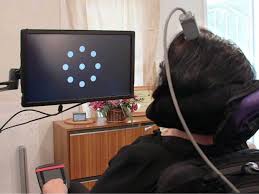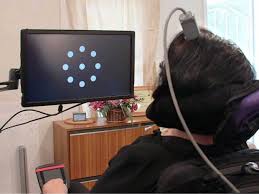
Bringing scientists one step closer to helping people who are completely paralyzed engage with the outside world, a California woman with a chip implanted in her brain has successfully browsed the web using a tablet powered by her thoughts.
The woman is suffering from Amyotrophic Lateral Sclerosis, which is otherwise known as ALS or Lou Gehrig’s disease. While at the moment she can talk, manipulate objects and get around in a wheelchair, but the terminal disease will eventually render her completely paralyzed.
As part of a clinical trial called BrainGate 2m, the woman volunteered to let scientists implant a microchip in her brain. The scientists hoped that the they would be able to figure out how to help paralyzed people communicate by programming computers to read their minds.
The announcement of the success of the clinical trial was presented by Stanford postdoctoral researcher Paul Nuyujukian at the annual Society for Neuroscience Conference in Chicago last month. Nuyujukian announced that the women had been able to successfully operate a tablet using the technology.
Nuyujukian later said in an interview that the results of the clinical trial were replicated the results in a second participant on the east coast. However Nuyujukian sounded caution and said that the technology is still being tested for safety and it’s too early to say for sure whether it will have useful medical applications.
“This is still very much a research study. There’s no implication of clinical benefit,” he said.
However optimists are of the view that if the future trials prove successful, the same technology could also allow paralyzed people to control robot arms and other prostheses with their thoughts.
A custom piece of software with a virtual keyboard was developed by the tablet trial, BrainGate 2 scientists that allowed the participants to move a cursor and type out messages one letter at a time with their thoughts.
The part of the brain that is responsible for hand movements was selected by the scientists to implant the microchip and the participant was asked to imagine moving her index finger left and right on the tablet and her thumb up and down.
The chip is connected to computer software through a cable that was plugged into the side of the participant’s head. The computer software had he ability to interpret the thoughts of the participants and moved the cursor accordingly.
“In many ways, it’s like controlling a joystick on a gamepad, just with the mind instead of directly with one’s fingers,” Nuyujukian said.
However the scientists wanted a system that could predict sentences and words to make it easier and faster for participants to use. The scientists realized that the solution was very easily available and was just a click away. The scientists used a Bluetooth connection to pair a Nexus 9 tablet with an Android operating system to the computer interpreting the participant’s thoughts. The same the technology that powers a wireless mouse was used to links the computer plugged into the participant’s brain with the tablet.
“The science fiction mind can run very wild with these types of ideas. But as we are using it right now, these systems simply record information from the brain. That’s all there is to it,” Nuyujukian said.
(Source:www.business.financialpost.com)
The woman is suffering from Amyotrophic Lateral Sclerosis, which is otherwise known as ALS or Lou Gehrig’s disease. While at the moment she can talk, manipulate objects and get around in a wheelchair, but the terminal disease will eventually render her completely paralyzed.
As part of a clinical trial called BrainGate 2m, the woman volunteered to let scientists implant a microchip in her brain. The scientists hoped that the they would be able to figure out how to help paralyzed people communicate by programming computers to read their minds.
The announcement of the success of the clinical trial was presented by Stanford postdoctoral researcher Paul Nuyujukian at the annual Society for Neuroscience Conference in Chicago last month. Nuyujukian announced that the women had been able to successfully operate a tablet using the technology.
Nuyujukian later said in an interview that the results of the clinical trial were replicated the results in a second participant on the east coast. However Nuyujukian sounded caution and said that the technology is still being tested for safety and it’s too early to say for sure whether it will have useful medical applications.
“This is still very much a research study. There’s no implication of clinical benefit,” he said.
However optimists are of the view that if the future trials prove successful, the same technology could also allow paralyzed people to control robot arms and other prostheses with their thoughts.
A custom piece of software with a virtual keyboard was developed by the tablet trial, BrainGate 2 scientists that allowed the participants to move a cursor and type out messages one letter at a time with their thoughts.
The part of the brain that is responsible for hand movements was selected by the scientists to implant the microchip and the participant was asked to imagine moving her index finger left and right on the tablet and her thumb up and down.
The chip is connected to computer software through a cable that was plugged into the side of the participant’s head. The computer software had he ability to interpret the thoughts of the participants and moved the cursor accordingly.
“In many ways, it’s like controlling a joystick on a gamepad, just with the mind instead of directly with one’s fingers,” Nuyujukian said.
However the scientists wanted a system that could predict sentences and words to make it easier and faster for participants to use. The scientists realized that the solution was very easily available and was just a click away. The scientists used a Bluetooth connection to pair a Nexus 9 tablet with an Android operating system to the computer interpreting the participant’s thoughts. The same the technology that powers a wireless mouse was used to links the computer plugged into the participant’s brain with the tablet.
“The science fiction mind can run very wild with these types of ideas. But as we are using it right now, these systems simply record information from the brain. That’s all there is to it,” Nuyujukian said.
(Source:www.business.financialpost.com)





